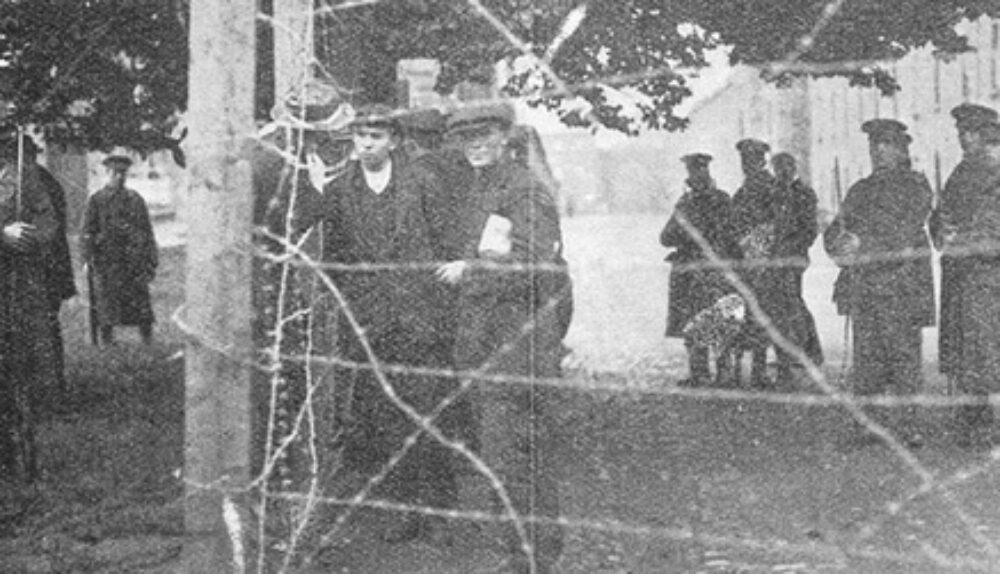Themes: Internment, Executions, Female Participation
Subject: History
Estimated No. of Classes: 2
Toolkit: Projector, Internet Connection, Computer Lab, Print Outs
Funders: The Department of Education and Skills and the Irish Research Council.
Developed by: The Letters of 1916 Project, The Military Archives, An Foras Feasa and The Humanities Institute at Maynooth University.
Download: Download
Back
"It was a harrowing experience"
Abstract:
This lesson plan will introduce students to the situation faced by rounded up rebels in the immediate aftermath of the collapse of the 1916 Easter Rising. The lesson can also be utilised to cover the final days and executions of sixteen leaders of the 1916 Rising. The lesson aims to teach students how to use and engage with online primary sources for research purposes and how to locate digitised material in a discerning way. The lesson will familiarise students with the collections on www.militaryarchives.ie. Students will examine digitised primary sources, interrogate images, research independently and report back their findings to the class about the experience and outcome of certain participants of the 1916 Easter Rising. The lesson gives students scope to focus on the experience and fate of particular members of the Irish Volunteers, Cumann na mBan, Irish Citizen Army and Na Fianna Eireann who were imprisoned following the collapse of the Rising.
Lesson Aims/Objectives:
a. To engage students in analysis of primary source material
b. To familiarise students with sites to aid their research in this area (www.militaryarchives.ie)
c. To equip students with a better understanding of the immediate aftermath of the 1916 Easter Rising and the outcome for participants of the 1916 Easter Rising
Advanced Preparation Required:
a. Teachers should ensure that www.militaryarchives.ie is whitelisted.
b. If internet access is not available for students (inside or outside the classroom), print-outs of the sources listed below can be distributed. The teacher may find it necessary to narrow the focus if print-outs are utilised for the lesson and focus areas are suggested below (see Materials Needed 10. ‘b’ - ‘d’).
c. The Teacher should determine the focus of the lesson and whether lesson will involve the participation of groups or individual students who will work alone inside or outside class time.
Methodology:
a. To provide context, the teacher should explain the collapse of the 1916 Easter Rising by focusing on the collapse of General Headquarters (GPO), the evacuation of the GPO and general surrender. An tOglach articles and the Sinn Fein Rebellion handbook (see Materials Needed 10. ‘a’) may prove useful.
b. The teacher could highlight a particular site of detention/Gaol to provide a starting point for the students’ research path if the lesson is to be conducted using online search of www.militaryarchives.ie
c. The teacher should instruct students on how to navigate the Military Archives site on the projector, if students are to research in their own time using online resources. The teacher should advise students on how to search and emphasise the need to be selective about using keywords (e.g. Richmond, Enniscorthy, Kilmainham) . Results are likely to be multiple and wide reaching in terms of subject matter; part of the research task of for students to filter results and speed read to determine which statements/pension records will be of most use for their research.
d. In the following class students will make individual 1-2 minute presentations or 5-7 minute group presentation on the selected individual, group, location (detention centre/Gaol).
Assessment:
a. Assessment of the student/group presentations, e.g. delivery, accuracy andrelevance of content
b. If the lesson demands that students are responsible for carrying out their ownresearch, the students will be asked to demonstrate how they found information on their research subject
Materials Needed:
a. Contextualisation:
i.An tOglach articles (see article titled A n tÓgláċ Evacuation of the G.P.O, 1916)
ii.Sinn Fein Rebellion handbook (page 4)
b. Focus on surrender
i. 16 Moore Street/Hanlon’s fish shop:
- Letter to Pearse BMH CD 075/1/4
- Witness Statement WS 242 - Liam Tannam PDF pages 41-45
- Witness Statement WS 340 - Oscar Traynor (PDF pages 24-26)
ii. Enniscorthy, Wexford:
- Images of the Enniscorthy prisoners - BMH CD 105/4/7
- Letter regarding the surrender - BMH CD 075/1/5
- Witness Statement WS 1216 - Very Rev Canon Patrick Murphy(PDF pages 6-10)
- Witness Statement WS 1041 - Tom Doyle (PDF pages 31-32)
- Witness Statement WS 170 - Peter Galligan (PDF pages 12-20)
c. Focus on prisoner conditions and experience while held in Dublin gaols
i. Conditions in Richmond barracks (detention barracks for majority of men and women rounded up following collapse of 1916 Easter Rising)
- Witness Statement WS 1041 - Tom Doyle (PDF pages 35-36)
- Witness Statement WS 371 - Robert Holland (PDF pages 37-38)
- Witness Statement WS 1766 - William O’Brien (PDF pages 13-23)
- Poetic response to the situation in Richmond – “Invocation” by Commandant Eamon DeValera – CD 329/20
- Letter to Geraldine Dillon (sister of executed Leader, Joseph Plunkett) from her father CD/005/8/06
- Witness Statement WS 358 - Geraldine Dillon (PDF pages 25-27)
ii. Conditions for female detainees

